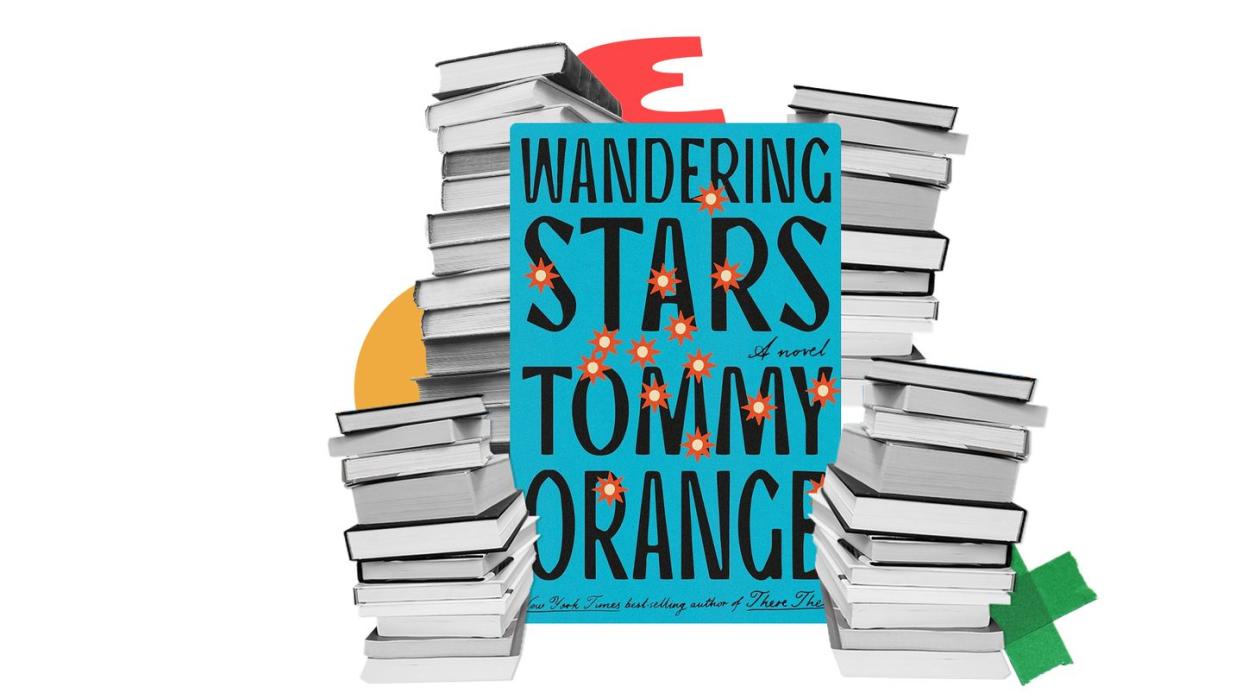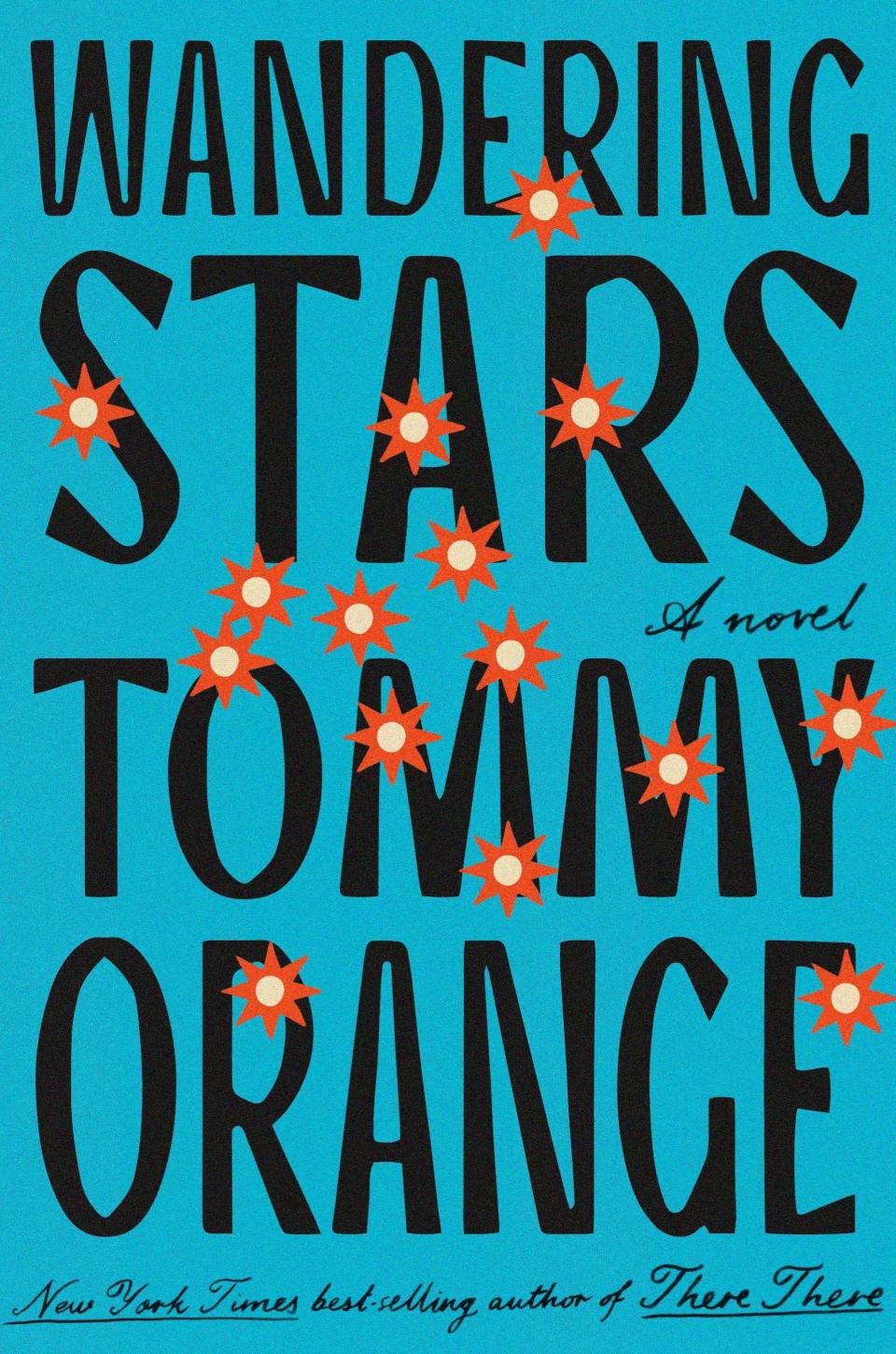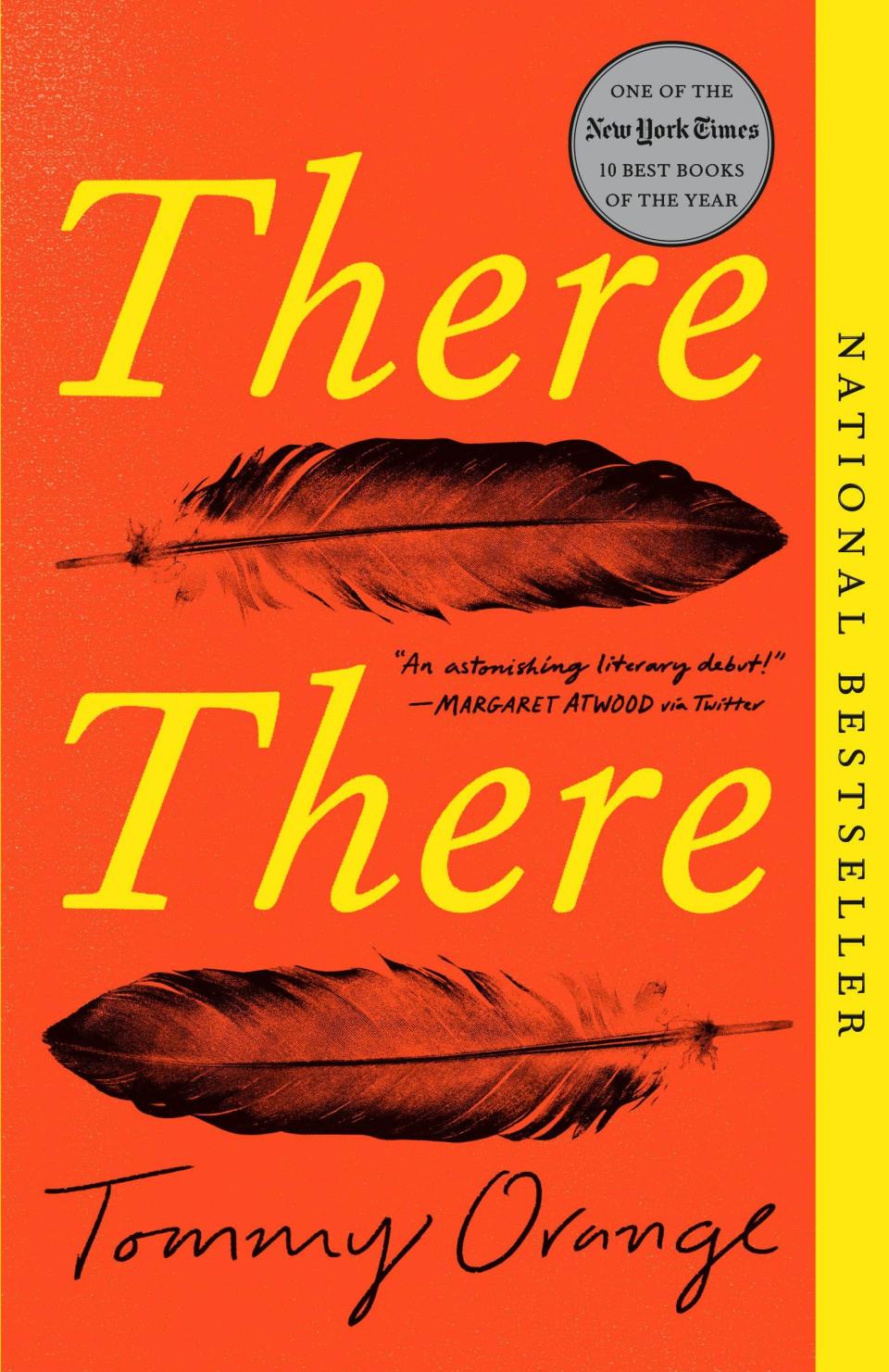Tommy Orange Refuses to Be Your Tour Guide to Native Life

- Oops!Something went wrong.Please try again later.
"Hearst Magazines and Yahoo may earn commission or revenue on some items through these links."
To quote the recently departed N. Scott Momaday (1934 – January 24, 2024), “If you believe in the power of words, you can bring about physical changes in the universe.” Wandering Stars, Tommy Orange’s follow-up to his massive hit There There, brings about changes to the universe—or at least the literary universe. It’s a follow-up, yes, but the first half of Wandering Stars does not immediately provide what readers might want: answers to the mystery surrounding the end of There There. Instead, we are thrust into prelude: Colorado, 1864, where we meet Star, a young survivor of the Sand Creek Massacre, who is brought to the Fort Marion prison castle. There, Star is forced to learn English and practice Christianity by Richard Henry Pratt, who went on to create the Carlisle Indian Industrial School, an institution dedicated to the eradication of Native history, culture, and identity.
“[T]he only good Indian is a dead one,” Pratt said in an 1892 speech. “Kill the Indian in him, and save the man.” That was the mission of his school and others like it.
A generation later, however, Star’s son, Charles, is sent to this school, where he is brutalized by the man who was once his father’s jailer. Under Pratt’s harsh treatment, Charles and a young fellow student envision a future away from the institutional violence that follows their bloodlines. That fellow student? Opal Viola, or for those coming straight from There There: Opal Viola Victoria Bear Shield. Her first and last name tell us all we need to know—she is as loving as she is protective, especially towards her grandsons Orvil, Lony, and Loother, whom she raises. In Wandering Stars, Orange gives you no choice but to fully understand the power of words.
I spoke with Orange by phone—because Native people have phones and TVs and coffee makers and even Chanel perfume—about the origins of this book, about “addiction” in Native literature, about readership, and about the importance of showing and writing history in fiction as we, the marginalized, come face to face with the power dynamics of the publishing industry’s standard of what “good” writing is. This interview has been edited for length and clarity.
ESQUIRE: Six years ago, There There was the Big Bang that expanded and exploded the many elements of language, such as words, grammar, style, and so on. Then, as time passed, the mass of these elements collapsed from gravitational attraction, and as it collapsed, the pressure built until it became hot enough to ignite fusion. Then, BOOM: stars, dotting the night sky where we can see them. For me, There There was the Big Bang, and Wandering Stars is its aftermath: an expansion that just like the real Beginning for us is expanding not just There There, but works written by Indigenous peoples. How did you come up with a title that feels so "perfect"?
TOMMY ORANGE: How I came up with the title is kind of ridiculous. It’s a little embarrassing, or if not embarrassing then not exactly romantic or inspiring in terms of where I was when I decided on Wandering Stars as a title. This was March 2018, a few months before There There came out. Those days, I was walking around like a deer in headlights. A lot of the blowing up of the book had already started—your idea of the Big Bang really did come with a kind of gravity that felt like it would eventually cause a kind of collapse. Part of that started when I was going to a Penguin Random House warehouse to sign thousands of books ahead of publication. A team of sales reps were helping me get through books as fast as possible. They’d put on a Spotify playlist with the root as Radiohead’s “There There.”

amazon.com
$26.10
I was sitting there signing books and “Wandering Star” by Portishead came on. In a single moment—again, that Big Bang you talked about—I knew I was writing a sequel and that it would be called Wandering Stars. I don’t know why I knew, but I felt sure. Interestingly, I didn’t even know at the time that Portishead drew some of its lyrics for “Wandering Star” from the Bible, which ended up playing a crucial role in the first part of the book. The reference to the Portishead song itself happens in the book as a very easy to find easter egg that you probably wouldn’t even notice if you don’t know the song or the name of the lead singer, Beth Gibbons.
One of the most striking aspects I love about Wandering Stars is the way the book, for some readers, appears to be two books: the first being the extensive history you include from the Sand Creek Massacre in 1864—out of which one survivor is a Red Feather family member—and the second being the aftermath of There There’s propulsive ending. As a skeejin, a Native, I can’t help but see this as one book for two reasons. First, we are our history—the good, the bad, the ugly and traumatic, and the strength and courage we carry in our blood. This history you write is delivered with a slow, melodic voice and a tone that is dichotomously gentle and harsh, easygoing and demanding. For me, your voice, your prose, is like hip hop—with There There, I think of Future and Migos for some reason, that speed and mumbling but you make it understandable. Wandering Stars, while still carrying that music-like voice, is much different. All that comes to mind is the ‘90s group Bone Thugs-n-Harmony. There is such a slowness to the voice that gives the book a commanding feeling. How did you find that voice without jeopardizing who you are as a writer?
It's super interesting how what comes to mind for you is Bone Thugs, and then you follow that up with a slowness to the voice when Bone Thugs was all about speedy delivery. I think there’s a different voice and writer happening in the second book. I became a different person. For better or worse, I changed. When I decided to write the follow-up, I really didn’t want to write the same book again. It felt like a real threat to artistic growth and integrity, to just do what worked the first time again, or to stray so far away from what made it a successful book that I would become some kind of one-hit-wonder. I had to find ways to quiet a lot of new voices and critics in my writing space.
I didn’t write the first book with an audience in mind. But it felt undeniable that regardless of what I wrote for the second book, people would read it just to find out. There is a kind of spectacle with the sophomore effort. It’s interesting whether it succeeds or fails. In wanting to write a different sort of book, I knew I would be sacrificing the propulsive nature of an easily identifiable plot with a gun appearing early on to drive the reader through. It was just more important to me to try and write something new than to figure out how to replicate what “worked” the first time.
For you, is this a sequel or is it part sequel, as some have called it? If the latter, what does that mean? How can a book be “part” sequel?
Part sequel, part prequel is how it might be described, and I’ve even said the same. But like I said, I wanted to write something that felt distinct from There There. I did not want to write the same book again. Writing sequels and writing sophomore novels—especially when the first book has success—is sort of a doomed endeavor. The way the prequel part of Wandering Stars came in was completely by chance. I almost didn’t go to Europe for a little European tour for the translation of There There into Swedish, Dutch, and Italian. Had I not gone, Wandering Stars might have been a completely different book. Not part sequel at all, but full sequel.
I was invited to a museum in Sweden where they had some of my people’s stuff behind glass. I don’t like museums, generally, partly because of how many people’s ill-gotten stuff they still have on display behind glass. But I went and I saw this newspaper clipping about Southern Cheyennes in Florida. I knew enough about my tribe’s history to know we were never in Florida. I ended up falling down a rabbit hole about this piece of history. As we speak, I’m on my way to the prison castle called Fort Marion where prisoners of war were kept, half of them Southern Cheyenne, from 1875 - 1878. This was the blueprint for the Carlisle Indian Industrial School and countless other boarding schools around North America for centuries.

amazon.com
$8.89
I’ve got another long question for you, nitαpe (brother). Fiction writer, scholar, and critic Louis Owens, of Choctaw and Cherokee descent, discusses what he refers to as “literary tourism.” He writes, “Too often… not only students in our classes but readers at large (and, of course, publishers) want not literature that challenges them to think and feel in new ways but literary works that provide a comfortable, easy tour of colorful Indian Country.” When I was an undergraduate, I took a Native American Literature course, and the Professor asked everyone to say their name, what they’re studying, and why they’re taking the course. One person responded by saying, “Well, I’m, uh, really interested in arrowheads, and so I thought this would be a great fit.” By the way, this was at an Ivy League school. (During my four years there I developed rashes, and it wasn’t until I graduated that I realized I was allergic to ivy.) Soon, readers from all backgrounds will get the chance to crack open Wandering Stars, which gives little opportunity for a tour, unless a reader considers the historical narrative that composes much of the book to be a tour, which I’d argue it isn’t. I’m curious: how do you, as a Native writer, do this? How do you challenge your readers? More importantly, how do you challenge those readers who are looking for that “comfortable, easy tour of colorful Indian Country” and keep them reading?
It’s interesting what the responses are from Native readers versus non-Native readers versus white readers. I’ve never heard a Native reader talk about the work being hard or heavy or difficult or sad or painful; only a kind of exuberance at hearing familiar stories and feeling seen on the page. I’ve never been good at giving any kind of easy tour of Native life. Being good at doing that probably precludes being good at representing actual Native life. It’s always awkward to hear people over-emphasize how hard the life of my characters was to experience. Honestly, my actual life is sadder than the life of most of my characters, if we’re talking about sadness being based on comparing a life to white middle-class normality. When I’m writing and revising, I really try to think about readability—the sound of the writing when I read it out loud, akin to a musician listening to the sound of their music to see if it’s working sonically. The meaning and themes that come through are what I feel compelled to write about because it’s a part of my experience.
There There ends in mystery, yet readers know Wandering Stars’ second half picks up where you left us. There, readers encounter addiction, substance abuse, and the associated struggles. Native writers hear time and time again from non-Natives about addiction being a trope that has run its course. Those readers say, “We get it, but what else do you have?” Those readers want a new kind of literary tourism, maybe—one where they get to “touch” the exotic in a new way. How did you approach addiction, and how did you write about it as honestly as you did?
Addiction has shaped and mangled and scarred my life, but also perhaps enriched it, even while threatening its livability. It is important to me because it has played a prominent role in my life. I wanted to write about it in a way that felt human, and not like a trope. So many of us are “touched” by addiction, whether we recognize it or not. It is a gravity that we orbit as humans. There is a thread of addiction throughout this novel, and I wanted to show it as something that people go to to cope with other difficulties related to colonization, not simply a problem unto itself. Addiction as a problem unto itself certainly exists, yes, but Native people have been misaligned with addiction as if it is a weakness of ours, rather than looking at why we, as a whole, as a collective, might develop problematic relationships to substances that serve as a kind of medicinal salve. I didn’t do much research regarding addiction because I have so much personal experience with it.
I’ve got one more question for you, a curveball—something that I as a Native writer think a lot about. Many universities offer courses in Native American Literature, African American Literature, Asian American Literature, and others that focus on the work produced by a specific ethnic demographic that is not white. Many of these courses are tucked in universities’ English departments. Two questions: first, should English departments offer courses titled something like, “White People Literature”? Second, for those universities that have Native American Studies Programs, should they also offer courses like, “How to Read White People Literature”?
I love the idea of having a white literature section! It is the ruler by which we and critics and institutions often measure our work. When I was on book tour for There There, I was not surprised to find There There in the Native American section of the book store rather than in the general fiction section. I think it’s important to understand power dynamics and the publishing industry and why white men are the majority of the canon of what is considered the best of what literature can do, to understand history and white supremacy and this country and nationalism and eugenics and a slew of other aspects of what we consider when we consider what good writing is. The sad truth is that it will take decades to undo a lot of how we consider what good and important writing is outside of just accepting as a baseline that these white male writers are the GOATS. But it’s unlikely that people in positions of power will want to undo things that are already considered canon and built into so much curriculum. I’m not saying all white male writers shouldn’t be considered great. Many of the writers that continue to be celebrated and taught are very good. But talent and innovation and greatness are not something we lack, as an American writing culture. Good and great books continue to be written, and there are so many books we haven’t studied and taught enough.
Take Toni Morrison, for example. I believe she is the actual GOAT. And yet I feel she is more taught in a context of, “If you care about African American blah blah blah…” instead of, "Study her sentences.” No one does it better than her. She is beyond comparison. Louise Erdrich is in that same category. But Native people and people of color are often kept as sort of genre writing. If you care about these people or history, you might like them, and white writers are just writing about relatable life, which is ridiculous, of course. But the market is still driven by middle-class middle-aged white women. And it is an industry, in the end. So that is, inevitably, what publishers think about when acquiring books. I think there is much to be hopeful about in regards to representation in publishing and in media in general now, so I don’t want to sound too jaded. But there is data out there around who is being published, and white people continue to compose around 75% of all books published. I’m really happy and hopeful about the state of Native literature right now, and I don’t want to sound too jaded, like I said, but I don’t want to be naive. There is much work to do.
You Might Also Like

